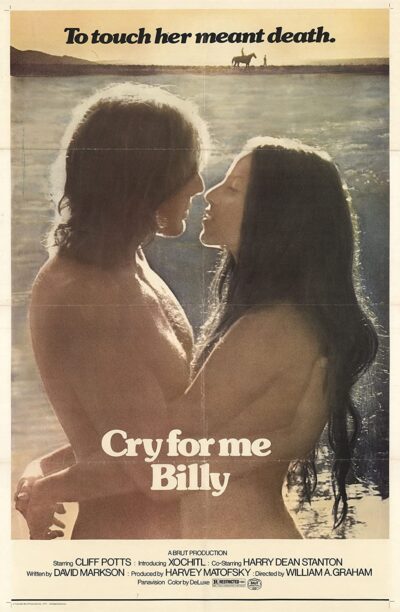 One of the more obscure entries in the revisionist western craze of the 1970s, this quasi-art film (given new life in 2023 by Quentin Tarantino and Roger Avary on their VIDEO ARCHIVES podcast and YouTube channel) hails from 1972. Starring the prolific 1970s and 80s supporting player Cliff Potts and visualized by the great Jordan Cronenweth (of BLADE RUNNER), CRY FOR ME BILLY been compared with SOLDIER BLUE (1970) and THE HUNTING PARTY (1971), but in actuality it’s closer to the more esoteric likes of ZACHARIAH and THE HIRED HAND (both 1971).
One of the more obscure entries in the revisionist western craze of the 1970s, this quasi-art film (given new life in 2023 by Quentin Tarantino and Roger Avary on their VIDEO ARCHIVES podcast and YouTube channel) hails from 1972. Starring the prolific 1970s and 80s supporting player Cliff Potts and visualized by the great Jordan Cronenweth (of BLADE RUNNER), CRY FOR ME BILLY been compared with SOLDIER BLUE (1970) and THE HUNTING PARTY (1971), but in actuality it’s closer to the more esoteric likes of ZACHARIAH and THE HIRED HAND (both 1971).
…given new life in 2023 by Quentin Tarantino and Roger Avary on their VIDEO ARCHIVES podcast and YouTube channel…
Billy (Potts) is a frequently shirtless blonde gunslinger on a trudge through the Wild West. After happening on an estranged colleague (a young Harry Dean Stanton) Billy establishes his virtuous nature by attempting to save some Native Americans from being manhandled by a vicious blacksmith (Roy Jensen). The attempt backfires, as the blacksmith is backed up by a group of rogue soldiers who precipitate a mini-massacre. Billy ends up canoodling with a young Native American woman named Xochitl (Potts’ then-wife Maria) who survived the massacre and has retreated into a nearby forest. She initially rebuffs Billy’s advances, only to grow enamored with his supposedly irresistible nature.
CRY FOR ME BILLY Trailer
But as any revisionist western buff well knows, trouble is on the horizon. The rogue soldiers interrupt the idyll, tying Billy up and gang raping Xochitl, who subsequently commits suicide. Billy warns his tormentors that they’d better kill him but they don’t listen, riding off and leaving him to free himself—and enact a bloody revenge.
On display is a highly spare and deliberate style that director William A. Graham, working from a script by novelist David Markson, would put to especially memorable use in later films like the scenic family saga WHERE THE LILIES BLOOM and the Blaxploitation drama TOGETHER BROTHERS (both 1974). That style, combined with Jordan Cronenweth’s naturally lit visuals, carries the viewer through a very slow moving film with performers whose primary appeal is their frequently nude appearance (it’s hard to tell whether or not Potts and his spouse can truly act).
…carries the viewer through a very slow moving film with performers whose primary appeal is their frequently nude appearance (it’s hard to tell whether or not Potts and his spouse can truly act).
Precisely how much of the lengthy dialogue-free portions, taken up with carousing and nude horseback riding, and set to very seventies-centric folk tunes by Michael Franks, can be termed poetic naturalism (rather than shameless padding) remains an open question. Nor is the film immune to the silliness that pervaded so many seventies oaters, as in a scene in which Potts and Stanton assume crucifixion poses as part of a shooting game (a la Kris Kristofferson in a much-criticized bit from PAT GARRETT AND BILLY THE KID). It is, in short, very much a product of its time, down to the counterculture posturing (as established by the line “A man gets over 40 they oughta lock him up!”).
That period-specific air extends to the cynical and unsparing gist. The revisionist western era tended to promote “anti-westerns” that decried the conservative bent of traditional American-made oaters, and had very bleak arcs. It’s certainly no accident that CRY FOR ME, BILLY’s chief antagonists are military men, or that the hero’s climactic crusade doesn’t end happily.
Vital Statistics
CRY FOR ME BILLY
Brut
Director: William A. Graham
Producer: Harvey Matofsky
Screenplay: David Markson
Cinematography: Jordan Cronenweth
Editing: Jim Benson
Cast: Cliff Potts, “Xochitl” (Maria Potts), Harry Dean Stanton, Don Wilbanks, Woodrow Chambliss, Floyd Baze, Wayne McLaren, John Bellah, Bud Walls, Tom McFadden, James Gammon, William Carstens, Roy Jensen, Richard Breeding
